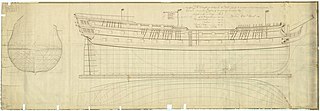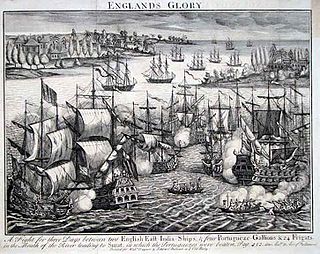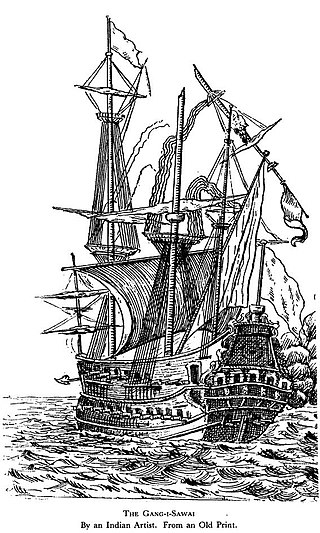Related Research Articles

The East India Company (EIC) was an English, and later British, joint-stock company founded in 1600 and dissolved in 1874. It was formed to trade in the Indian Ocean region, initially with the East Indies, and later with East Asia. The company gained control of large parts of South Asia and Hong Kong. At its peak, the company was the largest corporation in the world by various measures and had its own armed forces in the form of the company's three presidency armies, totalling about 260,000 soldiers, twice the size of the British Army at certain times.

HMS Colossus was a 74-gun third-rate ship of the line of the Royal Navy. She was launched at Gravesend on 4 April 1787 and lost on 10 December 1798. During her years of service she participated in the Battle of Groix, the Battle of Cape St Vincent, and the Battle of the Nile. While carrying wounded from the latter, she was wrecked at the Isles of Scilly. The wreck is a Protected Wreck managed by Historic England.
HMS Sceptre was a 64-gun third-rate ship of the line of the Royal Navy, launched on 8 June 1781 at Rotherhithe. The ship was wrecked in a hurricane on 5 November 1799 in Table Bay near the Cape of Good Hope.

HMS Victory was a 100-gun first-rate ship of the line of the Royal Navy, built to the dimensions of the 1733 proposals of the 1719 Establishment at Portsmouth Dockyard, and launched on 23 February 1737.

The naval Battle of Swally, also known as Battle of Suvali, took place on 29–30 November 1612 off the coast of Suvali a village near the Surat city and was a victory for four English East India Company galleons over four Portuguese galleons and 26 barks.
Adventure Galley, also known as Adventure, was an English merchant ship captained by Scottish sea captain William Kidd. She was a type of hybrid ship that combined square rigged sails with oars to give her manoeuvrability in both windy and calm conditions. The vessel was launched at the end of 1695 and was acquired by Kidd the following year to serve in his privateering venture. Between April 1696 and April 1698, she travelled thousands of miles across the Atlantic and Indian Oceans in search of pirates but failed to find any until nearly the end of her travels. Instead, Kidd himself turned pirate in desperation at not having obtained any prizes. Adventure Galley succeeded in capturing two vessels off India and brought them back to Madagascar, but by the spring of 1698 the ship's hull had become so rotten and leaky that she was no longer seaworthy. She was stripped of anything movable and sunk off the north-eastern coast of Madagascar. Her remains have not yet been located.

Association was a 90-gun second-rate ship of the line of the Royal Navy, launched at Portsmouth Dockyard in 1697. She served with distinction at the capture of Gibraltar, and was lost in 1707 by grounding on the Isles of Scilly in the greatest maritime disaster of the age. The wreck is a Protected Wreck managed by Historic England.
John Taylor, born Richard Taylor, was an English pirate active in the Indian Ocean, best known for participating in two of the richest pirate captures of all time.
The Pirate Round was a sailing route followed by certain, mainly English, pirates, during the late 17th century and early 18th century. The course led from the western Atlantic, parallel to the Cape Route around the southern tip of Africa, stopping at Madagascar, then on to targets such as the coast of Yemen and India. The Pirate Round was briefly used again during the early 1720s. Pirates who followed the route are sometimes referred to as Roundsmen. The Pirate Round was largely co-extensive with the routes of the East India Company ships, of Britain and other nations.
The West Cornwall Steam Ship Company was established in 1870 to operate ferry services between Penzance, Cornwall, and the Isles of Scilly. It became the West Cornwall Steamship Company in 1907 and was wound up in 1917.
The Royal Merchant was a 17th-century English merchant ship that was lost at sea off Land's End in rough weather on 23 September 1641. On board were at least 100,000 pounds of gold, 400 bars of Mexican silver and nearly 500,000 pieces of eight and other coins, making it one of the most valuable wrecks of all time.

Doddington was an East Indiaman of the British East India Company (EIC). She made two trips for the EIC to Bombay, China, and Mokha. On her third trip she was sailing to India to remain there when she was wrecked on 17 July 1755 at Bird Island in Algoa Bay, near present-day Port Elizabeth. The ship was carrying a hoard of gold belonging to Clive of India, which modern treasure hunters looted. The controversy over these depredations resulted in changes to international maritime treaties to better protect underwater cultural heritage.

The Ganj-i-Sawai was an armed Ghanjah dhow belonging to the Mughals. During Aurangzeb's reign, it was captured on 7 September 1695 by the English pirate Henry Every en route from present-day Mocha, Yemen to Surat, India. It was built on the order of Empress Mariam-uz-Zamani, great grandmother of Aurengzeb, after the capture of her ship named Rahimi.

The Scilly naval disaster of 1707 was the loss of four warships of a Royal Navy fleet off the Isles of Scilly in severe weather on 22 October 1707. Between 1,400 and 2,000 sailors lost their lives aboard the wrecked vessels, making the incident one of the worst maritime disasters in British naval history. The disaster has been attributed to a combination of factors, including the navigators' inability to accurately calculate their positions, errors in the available charts and pilot books, and inadequate compasses.

The English overseas possessions comprised a variety of overseas territories that were colonised, conquered, or otherwise acquired by the Kingdom of England before 1707.

Nancy was a schooner or ship launched at Bombay. In 1778 the British East India Company (EIC) government at Bengal acquired her to use as a warship at Calcutta. The EIC Board of Governors in London vetoed the idea and Nancy became an express packet ship. She made two voyages from Bengal to Ireland between 1782 and 1784, and was wrecked on the second of these.
John Jourdain, was a captain in the service of the English East India Company (EIC), and the first president of the EIC Council of India
References
- ↑ Stevens, Todd (2012). "The 'Uprising' of 1648". Scillypedia. Retrieved 26 December 2012.
- ↑ Todd Stevens. The Pirate John Mucknell. p. 18.
- ↑ Rawlinson, H.G. (1920). British beginnings in western India, 1579-1657: an account of the early days of the British factory of Surat.
- 1 2 Stevens, Todd (October 2011). The Pirate John Mucknell and the Hunt for the Wreck of the John. AuthorHouse Publishing. ISBN 978-1467001588.
- ↑ "Wreck of pirate ship found off the Scillies may hide a treasure trove". Western Morning News. 2 June 2012. Retrieved 29 July 2012.
- ↑ "Update: English Heritage Surveying Potential Pirate Ship Site". scillytoday. 14 June 2012. Retrieved 29 July 2012.
